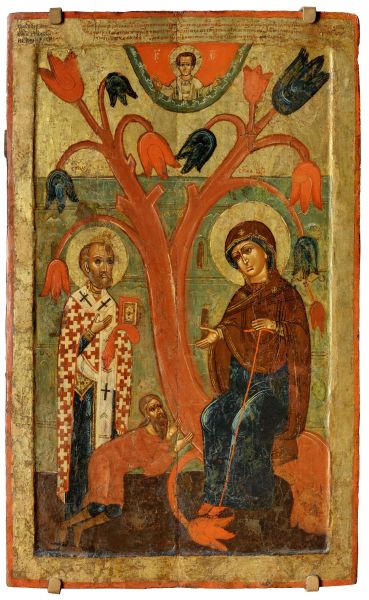|
|
The Appearance of the Mother of God and Nicholas to the Sexton Yurysh. Late 17th century. Russian North

Tempera on wood
89 х 55 х 3,3
State Russian Museum
Annotation
The legend of the appearance of the Mother of God to the Tikhvin sexton Yurysh is outlined in the “Tale of the Tikhvin Icon of the Mother of God,” which was widely circulated in Rus. Individual episodes from it served as the basis for the creation of a number of independent compositions, one of which is this icon.
The “reverent husband” Yurysh was sent to surrounding settlements to “inform people about the consecration of a new church” in Tikhvin. On the way back, he saw the Virgin Mary in the woods, sitting on a log and in front of her, a luminous man with gray hair. The Virgin Mary was unhappy because they were going to put an iron cross on the new church, and she implored him to install a wooden one instead, since Her Son and God was crucified on a wooden cross, not an iron one. The uniqueness of northern painting is fully embodied in the composition. Evidently, this is the “tree of life” from the Garden of Eden, which is suggested by the high wall reminiscent of those surrounding the Garden of Eden, and the 12 tulips on the branches evoke the biblical image of the tree “12 crops of fruit”.
In the “Legend” and the inscription that repeats it on the icon itself talks about the disobedience of the Virgin Mary’s request on the part of the residents of Tikhvin by their erection of an iron cross instead of a wooden one and the punishment of the guilty. This legend was especially popular among carpenters, who were defended by their patron saint, Nicholas, and the Virgin Mary. Then the appearance of the life-affirming image of the tree also becomes understandable, visibly proving the victory of the consecrated, age-old tradition of the material. Several naïve poetic legends had an impact on the work’s style, which is lively and expressive in its artistic language. The motif of the winding floral ornament, in which the figures of the saints are inscribed organically, and the flashing bright flame on the dim greenish background of tulip buds bring to mind the folk paintings of the North

